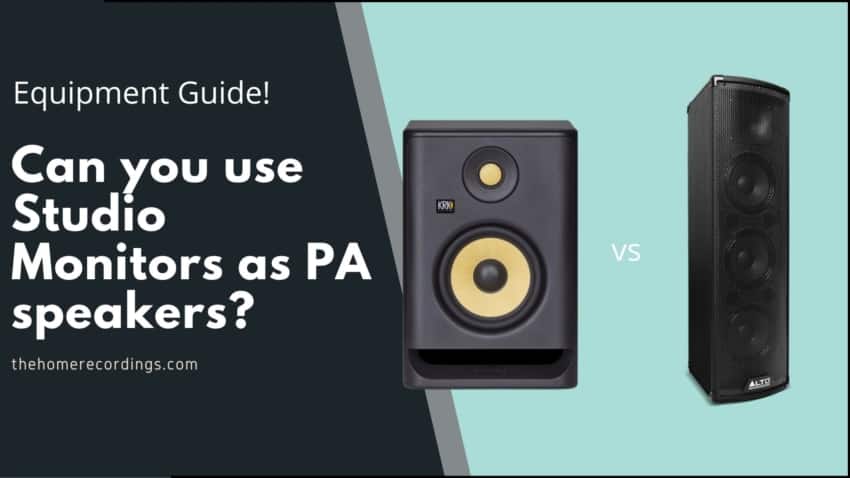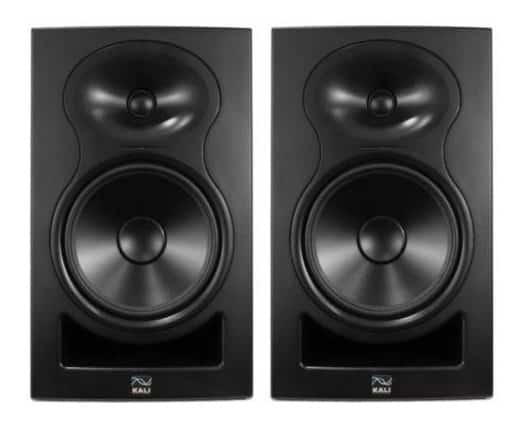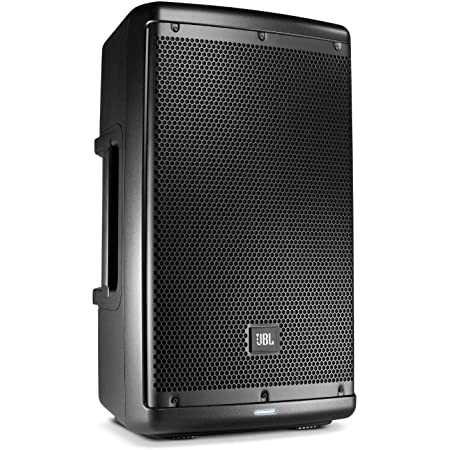Last updated on December 31st, 2023 at 06:02 pm
With so many different kinds of speakers out there, PA, Hi-Fi, Studio speakers, etc., it’s hard to know which one to use for what purpose and why. Also, are there really any differences or is it just marketing to get us to spend more?
In this article, I will go over the differences between studio monitors and PA speakers, what they are, what they are generally used for, and if you can use one as the other.
So, without further ado, let’s get started!
Can you use Studio Monitors as PA speakers? Studio monitors are designed to reproduce sound as accurately as possible at a relatively low volume, while PA speakers are designed to sound as loud as possible, sacrificing audio quality. Studio monitors won’t be able to reproduce audio as loudly as a PA system and will also suffer damage over time since they are not designed to be pushed as hard.
If you are thinking about using your studio monitors for a live show, I’d advise against it unless you’re willing to buy new ones or to now have terrible-sounding monitors.
Let’s take a closer look at what studio monitors and PA speakers are and if they are somewhat interchangeable.
What are Studio Monitors?
Studio monitors are loudspeakers specifically designed for professional audio production applications, such as recording studios, filmmaking, television studios, radio studios and project or home studios, where accurate audio reproduction is crucial and they are used for “critical listening”.
Generally, studio monitors are designed to sound as flat as possible, or to have a flat frequency response, where there’s no extra EQ cutting or boosting specific frequencies to make them sound better, but rather to help them reproduce audio as accurately as possible since you need to be able to hear what is going on in the mix.
Studio monitors are also Close-field, or Near-field speakers, which means that they are small enough to sit on a stand or desk in proximity to the listener, so that most of the sound that the listener hears is coming directly from the speakers, rather than reflecting off of walls and ceilings (and thus picking up coloration and reverberation from the room).
Just as a sidenote, there are also mid-field and even far-field monitors, but these are designed mostly for filmmaking where simulating larger environments is necessary.
Studio of studio monitors come with a woofer, designed for reproducing low-frequency sounds, or bass, and a tweeter, designed for reproducing the higher frequencies. But in some cases, you can also get an additional subwoofer if you need to reproduce the really low-end more accurately.
In short; Studio monitors are designed with accurate audio reproduction in mind, where no frequencies are boosted or attenuated on purpose to color the sound, or to make them sound better, which is why they are often referred to as “flat” and why they are used in music production, filmmaking, etc. Additionally, since they are near-field speakers, they are not designed to sound very loud.
If you’re thinking of getting your first set of studio monitors, then make sure to check out this article I wrote about the best studio monitors under $300.
What are PA Speakers?
A PA system, or Public Address system, is an electronic system comprising of audio equipment, such as microphones, amplifiers, loudspeakers, etc., that is designed to increase the loudness of different audio sources, such as the human voice, music in general, instruments, etc.
PA systems are used in any public venue that requires that an announcer, performer, etc. be sufficiently audible at a distance or over a large area.
Therefore, PA speakers are designed to sound as loud as possible to reach as many people as possible, and it’s exactly the type of system you see being used in live concerts, both for reproducing audio for the audience (Main system), and for the musicians for monitoring purposes (monitor system).
Now, as you may have guessed, since PA systems are designed to be loud, they are probably lacking in some other area, right?
Well, they are not considered high-end audio systems, or in other words, they don’t sound all that good and don’t reproduce audio as accurately as studio monitors or even regular Hi-Fi speakers, in fact, they cut off some of the low end (they generally don’t reproduce anything below 60Hz), and the high end is also cut to some extent, making them sound more nasally.
So, in short: PA speakers are designed to sound as loud as possible while sacrificing overall audio quality and not reproducing music as accurately as other systems.
Why studio monitors should not be used as PA speakers
I just told you that Studio Monitors sound better, or should I say “more accurate”, than PA speakers, so why not use them for live performances or for situations where people usually use PA systems?
Studio Monitors are near-field monitors, meaning that they are designed to be listened to from a very close distance, which is why they can’t reach extremely high volumes without suffering damage and sounding distorted, especially over extended periods of time.
Studio Monitors should never be used as PA speakers since you will likely ruin them, plus they will never be able to reach the volume necessary to work as PA speakers.
But what about the opposite scenario? Can you use PA speakers for music production?
Can you use PA speakers as Studio Monitors for producing music?
PA speakers are designed with loudness in mind, not accurate sound reproduction. They cut off the very low- and high end of the audio spectrum, making it sound more nasally and overall less accurate than both studio monitors and Hi-Fi speakers. This means that recognizing unbalanced frequencies that might need to be tamed will be much harder, or impossible, when mixing on PA speakers.
PA speakers are not considered to be High-performance speakers and are definitely not as well suited for music production or for studio use. If you can’t afford- or don’t have studio monitors, then consider using regular Hi-Fi speakers.
How to choose PA speakers vs Studio Monitors?
If you read the entire article, you should already have a good understanding of which type of speaker to get depending on your needs.
However, here are the things you should consider:
Get studio monitors if:
- You are producing/mixing/mastering music, making movies, YouTube videos, etc.
- If you want high quality speakers to listen to music (Hi-Fi systems might be more appealing if you’re only interested in listening and not producing).
Get a PA system if:
- You need to reproduce audio loudly to a large audience or in a public venue (live show, bar, cafe, etc.).
Conclusion
It’s safe to say that studio monitors should not be used as PA speakers, unless you’re willing to risk ruining them and at the same time have the audience not be able to hear the music properly because of how low the volume of those studio monitors is.
If you’re looking for an audio solution for producing music, then studio monitors are definitely the way to go.
Now, PA systems are designed to reproduce sound as loud as possible without too much consideration for audio quality, which is also why you may want to avoid them for regular music listening, mixing, mastering, and music production in general.
I hope this information was useful!
Have a nice day!


